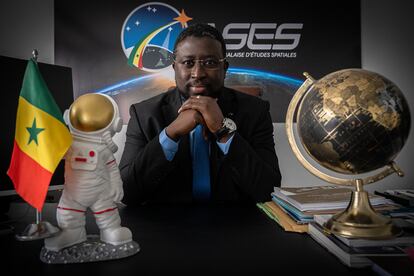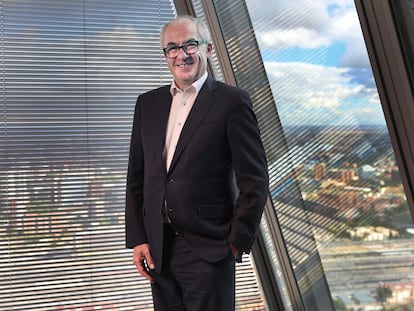Maram Kairé, Senegalese astronomer: ‘The development of the African continent will depend on the space sector’
The director of the Senegalese Space Study Agency has just led the launch of the first Senegalese nanosatellite into space

Maram Kairé, 46, is the star of the documentary Star Chasers of Senegal. And his life could also be a movie. He has just launched the first Senegalese nanosatellite into space, an asteroid bears his name, he has led three missions for NASA and promotes a space bus that travels through Senegalese villages showing stars. He speaks about astronomy with passion, the same passion he felt when he discovered that there were people who went to space at the age of eight. An engineer by training, but a self-taught astronomer, Kairé has been the director of the Senegalese Space Study Agency (ASES) since its foundation in 2023.
Question. How did your passion for space come about?
Answer. The first time I heard about space was with the explosion of the Challenger shuttle in 1986. We lived in a town with no electricity and we watched television hooked up to my father’s car battery, only during the news broadcasts. When I was 12, I picked up the book Atoms of Silence: An Exploration of Cosmic Evolution by Canadian astrophysicist Hubert Reeves from the school library, and from that moment on I never stopped looking at the sky.
Q. Was it easy to follow your dream?
A. I knew that I wanted to spend my whole life researching space. When I finished high school, I went to France to study at university, but my father didn’t want me to study astronomy. His argument was that with that degree I wouldn’t be able to work in Senegal and he wanted me to come back. So I opted for computer science, which made my father happy and allowed me to get closer to the space sector. After a few years, I returned to Senegal and worked as a computer scientist because there was no training or infrastructure for the development of astronomy. So I dedicated myself to educating and creating that infrastructure, so that in the future young people who dream of the stars can remain in the country.
Q. Upon your return, you did scientific outreach with the Senegalese Association for the Promotion of Astronomy (ASPA). What strategies did you use with children and their families?
A. We have developed a school program, two festivals in Saint Louis and Dakar, with several editions, and a space bus. The latter is a caravan project, which will be restarted in April 2025 and which proposes setting up temporary “scientific villages” in 27 locations throughout Senegal with a team of more than 60 facilitators. It is a major campaign to promote astronomy and science in general, which has been replicated in Morocco and France.
Q. In Senegalese popular culture there are many beliefs related to the sky, the stars, or the moon. How do you reconcile this traditional knowledge with modern science?
A. We do not go against local knowledge. At the Saint-Louis Under the Stars festival in 2009, we set up telescopes on the beaches of Guet Ndar. There, the fishermen explained to us how they use the stars to guide themselves without GPS, and we taught them how to read the map of the sky. In addition, for 15 years we have been working with the Crescent Moon Commission, a council of wise men who determine the appearance of the moon in the holy month of Ramadan. It is a very sensitive issue, so we share our astronomical calculations with them, but we also accompany them on the coast in their observations, highlighting their methods.
Q. Although you are not a trained astronomer, you have been appointed by NASA to carry out tasks of great responsibility in Senegal.
A. After not being able to study what I wanted, it was a dream that NASA counted on me to coordinate its teams. The first mission was in 2018 to observe the most distant space object in the solar system, a rock behind Pluto, in the Kuiper Belt. We were then entrusted with two more missions to observe occultations of Trojan asteroids of the planet Jupiter in the framework of the launch of the Lucy probe: Polymeles, in September 2020, and Orus, in October 2021. These were complex tasks that we successfully completed and that led us to gain the trust of NASA, with whom we continue to collaborate. It is a source of pride that Senegal is associated with these prestigious tasks that benefit all humanity.
Q. What is the other Maram Kairé, the asteroid, like?
A. [Laughs] It’s very dark and hidden somewhere in the asteroid belt. It’s five kilometers in diameter and takes four and a half years to go around the Sun. The recognition was granted by the International Astronomical Union. It’s incredible to think that the name of a Senegalese person will remain engraved around the Sun for millennia after his existence.
Q. Since its founding in 2023, you have headed the Senegalese Space Study Agency. What are the political challenges behind this institution?
A. A developing country like Senegal has great demands, such as improving access to water, electricity, and healthcare for its population. Convincing the president of the priority of creating a space agency was not easy, but our outreach work for 16 years and with NASA confirmed the importance of positioning ourselves in the space sector. The priority now is the transfer of skills and technologies in the agreements we are signing with Turkey, China, the United States, and France.
Q. Last August, the first Senegalese nanosatellite, GaindeSat, was launched. It was designed and built 100% by local engineers. What is its function?
A. GaindeSat [Gainde means “lion” in the Wolof language and is the symbol of Senegal] collects data on water levels in the country. This reduces the dependence on large human-resource devices that had to be deployed in the field, reduces errors, and multiplies the number of measurements that can be taken in a period of time. The data is exploited by the Ministry of Higher Education.
Q. What are ASES’s upcoming projects?
A. We are working on building our first satellite constellation, consisting of three units of two nanosatellites each. We are preparing the first two with the French company Prométhé Earth Intelligence, which we hope will be launched in 2027. But for me, what is really important is the construction of a satellite assembly, testing, and integration center so that the other satellites in the constellation can be manufactured in Senegal.
Q. The space sector is a priority for the African Union, which will inaugurate the headquarters of the African Space Agency (AfSA) in Cairo in April. What are the key issues in this space race?
A. Since 2018, the AU has had the ambition to develop this strategic sector. Almost half of African countries have a space agency. Senegal’s, created in 2023, is the 22nd, and others such as the Ivory Coast and Burkina Faso are in the works. It is expected that by 2030 there will be 100 satellites launched from the African continent [currently there are 59 belonging to 15 countries]. We Africans have realized that all the problems that concern us have a possible spatial response: tele-education, telemedicine, smart and precision agriculture, livestock monitoring, border security, maritime surveillance, control of natural resources... The development of the continent will inevitably involve mastery of science and technology, and today the most interdisciplinary sector is space. Africa understands that it is necessary to develop an economy around space.
Q. What does it mean on a symbolic level?
A. Technological sovereignty goes hand in hand with sovereignty in decision-making. When Africans have sufficient technological mastery to control what happens above our heads, we will create relationships of trust. The space sector is collaborative, we will work with those who are more advanced, but the relationship must be beneficial for all and not create dependencies.
Q. When you see a shooting star, you make a wish. What is yours?
A. Making Senegal a space nation.
Sign up for our weekly newsletter to get more English-language news coverage from EL PAÍS USA Edition
Tu suscripción se está usando en otro dispositivo
¿Quieres añadir otro usuario a tu suscripción?
Si continúas leyendo en este dispositivo, no se podrá leer en el otro.
FlechaTu suscripción se está usando en otro dispositivo y solo puedes acceder a EL PAÍS desde un dispositivo a la vez.
Si quieres compartir tu cuenta, cambia tu suscripción a la modalidad Premium, así podrás añadir otro usuario. Cada uno accederá con su propia cuenta de email, lo que os permitirá personalizar vuestra experiencia en EL PAÍS.
¿Tienes una suscripción de empresa? Accede aquí para contratar más cuentas.
En el caso de no saber quién está usando tu cuenta, te recomendamos cambiar tu contraseña aquí.
Si decides continuar compartiendo tu cuenta, este mensaje se mostrará en tu dispositivo y en el de la otra persona que está usando tu cuenta de forma indefinida, afectando a tu experiencia de lectura. Puedes consultar aquí los términos y condiciones de la suscripción digital.
More information
Archived In
Últimas noticias
The metaverse, four years later: Is it finished or just at a standstill?
$3,000 and a plane ticket: The United States increases incentives for migrants to self-deport before the end of the year
Charles Dubouloz, mountaineering star, retires at 36 with a farewell tour inspired by Walter Bonatti
From the White House to diplomatic gifts: Lego wins over adult fans, brick by brick
Most viewed
- The low-cost creative revolution: How technology is making art accessible to everyone
- Families demand repatriation of bodies of Colombians who died in Ukraine: ‘This war is a slaughterhouse for foreigners’
- Christian Louboutin: ‘Young people don’t want to be like their parents. And if their parents wear sneakers, they’re going to look for something else’
- All the effects of gentrification in one corner of Mexico’s Colonia Roma
- Christmas loses its festive spirit: ICE fears cast shadow over religious celebrations










































